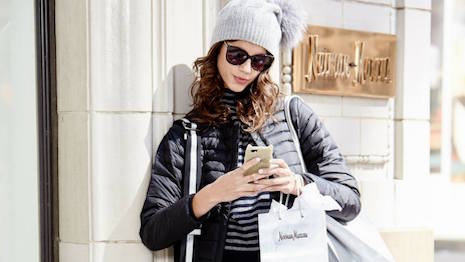- About
- Subscribe Now
- New York,
February 1, 2019

 Median mobile traffic increased 5 percent in 2018. Image credit: Neiman Marcus
Median mobile traffic increased 5 percent in 2018. Image credit: Neiman Marcus
Revenue in fashion ecommerce continues to increase across devices, despite consumers actually spending less time shopping online through briefer mobile sessions.
According to a new report from ecommerce platform Nosto, the average revenue per visit (RPV) increased globally by 33 percent on desktop and 38 percent on mobile from the beginning to end of 2018. However, online fashion shoppers still spend more time browsing on desktop than mobile devices.
“Mobile shoppers are impatient, yet they continue to accelerate their spending,” said Jim Lofgren, CEO of Nosto, New York. “The mobile share of revenue for fashion retailers now dominates desktop, but mobile shopping behavior isn’t becoming more similar to desktop.”
Nosto’s report was based on 1.2 billion site visits across 200 different online fashion stores. Data was analyzed for specific ecommerce regions including the United States, France and Northern Europe.
Mobile movement
By the end of 2018, median mobile traffic share to online fashion stores had increased 5 percent to an average of 62 percent.
Coinciding with this shift in traffic, mobile revenue share increased 9 percent from the first quarter to the fourth quarter to reach 46 percent. Meanwhile, desktop revenue share dropped 6 percent to 44 percent, with the remaining revenues stemming from other sources such as tablets.
Nordic shoppers were responsible for the highest mobile RPV. Image credit: TD Bank
In Northern Europe, mobile traffic accounts for 63 percent of all shopping visits from the region. The United Kingdom and the U.S. also experienced a majority of mobile traffic share at 61 and 53 percent, respectively.
Over the course of the year, global RPV increased by 33 percent on desktops and 38 percent on mobile. However, desktop still generates higher RPV compared to mobile at $2.76 to $1.44.
Nordic shoppers were responsible for the highest mobile RPV at $1.56, while French retailers had the lowest mobile RPV at $0.56. On the other hand, shoppers in Germany, Austria and Switzerland drive the highest desktop RPV at $2.60, which Nosto attributes to privacy and data concerns towards smartphones.
Worldwide, the average basket size – the total number of units sold per the number of invoices – remains higher on desktop than mobile at 2.45 versus 2.13.
Notably, shoppers in Northern Europe have the lowest average basket size despite their higher mobile RPV. This suggests that consumers in the region are more likely to make more expensive purchases on more frequent occasions rather than completing one order with a large number of items.
North American fashion lovers lead the way in average order value in both mobile and desktop, at $102 and $96 respectively. Globally, however, desktop AOV still outpaces mobile $120 to $103.
Average basket size remains higher on desktop than mobile. Image credit: Bloomingdale's
Length of session remained statistically steady on both desktop and mobile devices. Shoppers have a tendency to browse longer on desktop than on their smartphones, 239 seconds to 164 seconds.
“While average order values at least in the U.S. are quite close between desktop and mobile, consumers are still spending less time browsing on mobile, they convert at lower rates and by definition are simply seeing less of what a retailer has to offer,” Mr. Lofgren said. “This makes every micro-interaction that much more important, and in particular the personalization of what to show a consumer on mobile is incredibly important.”
Additional insights
Luxury retailers, particularly those with ecommerce origins, continue to innovate their mobile shopping strategies.
For instance, online luxury platform Farfetch has introduced a new visual search tool, the latest move by a luxury marketer to capture the attention of younger, more visually driven affluents.
Called “See It, Snap It, Shop It,” the new feature has been integrated into the retailer’s mobile application. Mobile and in-app shopping continues to gain traction among luxury consumers, motivating digitally-savvy brands to find new ways to innovate mobile shopping experiences (see story).
Retailers that invest in advertising their standalone mobile applications continue to find success, with an average of 63 percent of all their transactions coming from mobile shopping.
According to Criteo’s Q3 2018 Global Commerce Review, transactions completed on the mobile Web continue to rise across all regions. While omnichannel shoppers who make purchases in-store and online – including smartphones – are only one in 10 of all customers, they also account for more than a quarter of spending (see story).
“Luxury retailers need to obsess about every second of their mobile shopper journey,” Nosto’s Mr. Lofgren said. “The nature of the mobile experience means an increasing percentage of luxury shoppers are spending less time engaging with a retailer.
“Replicating the high-touch, in-store luxury experience is even more challenging on mobile than desktop – meaning an increasing reliance on technology like personalization to 'read their shoppers' minds' and curate each touchpoint to show the right products at the right time," he said.
Share your thoughts. Click here